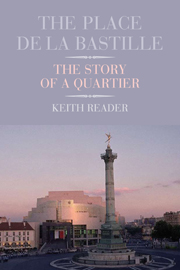Book contents
- Frontmatter
- Contents
- Acknowledgements
- Map by Stephen Ramsay Cartography
- Introduction: The Place de la Bastille
- 1 ‘What's that poor creature doing here?’: the area and the fortress before the Revolution of 1789
- 2 ‘Thought blew the Bastille apart’: the fall of the fortress and the revolutionary years, 1789–1815
- 3 ‘The strategy of the generals of Africa shattered’: the Restoration, Orleanist and Second Republic Years, 1815–1851
- 4 ‘Where is the noise of the storm that I love?’: The Second Empire from Haussmann to the Commune
- 5 ‘Satan's bagpipes’: La Belle Époque's forty-three years of peace
- 6 ‘Villains, stars and everybody in between’: The First War and the entre-deux-guerres
- 7 ‘Slicked hair and splendid sideburns’: Occupation and Liberation
- 8 ‘Let's have some sun!’: post-Gaullism and the Mitterrand years
- 9 ‘A building, not a monument’: the construction of the Bastille Opéra
- 10 ‘A real earthquake’: the impact of the Opéra on the quartier
- 11 Flânerie in the archive: the Faubourg/Bastille today
- Notes
- Bibliography
- Index
1 - ‘What's that poor creature doing here?’: the area and the fortress before the Revolution of 1789
- Frontmatter
- Contents
- Acknowledgements
- Map by Stephen Ramsay Cartography
- Introduction: The Place de la Bastille
- 1 ‘What's that poor creature doing here?’: the area and the fortress before the Revolution of 1789
- 2 ‘Thought blew the Bastille apart’: the fall of the fortress and the revolutionary years, 1789–1815
- 3 ‘The strategy of the generals of Africa shattered’: the Restoration, Orleanist and Second Republic Years, 1815–1851
- 4 ‘Where is the noise of the storm that I love?’: The Second Empire from Haussmann to the Commune
- 5 ‘Satan's bagpipes’: La Belle Époque's forty-three years of peace
- 6 ‘Villains, stars and everybody in between’: The First War and the entre-deux-guerres
- 7 ‘Slicked hair and splendid sideburns’: Occupation and Liberation
- 8 ‘Let's have some sun!’: post-Gaullism and the Mitterrand years
- 9 ‘A building, not a monument’: the construction of the Bastille Opéra
- 10 ‘A real earthquake’: the impact of the Opéra on the quartier
- 11 Flânerie in the archive: the Faubourg/Bastille today
- Notes
- Bibliography
- Index
Summary
The two buildings that gave the quartier its names represented, unsurprisingly, the two major repositories of power in pre-modern France: the (Roman Catholic) Church and the State. The area was, as its neighbour the Marais had been until cleared by the Knights Templar in the eleventh century, for long a marshy wasteland, traversed by an old Roman road leading eastwards out of the city. It was in 1198 that the Crusades preacher Foulques de Neuilly established a residence for repentant prostitutes on the site of what is now the Hôpital Saint-Antoine, at 184 rue du Faubourg-Saint-Antoine. This became a Cistercian abbey in 1204, whose abbess bore the title ‘La Dame du Faubourg’. In 1229 Louis IX bestowed upon it the title of Abbaye Royale, which was to foster considerable economic activity in the area; the marshes were drained, and the closeness of the Seine facilitated the arrival by water of building materials, including the wood which was to form the basis of the furniture industry. Louis VI's son and heir, Philippe, had been killed in 1131 when his horse was startled by a stray pig, since when pigs had been banned from the streets of Paris. Louis XI instituted an exemption from this prohibition for the abbey's pigs on condition that they wore a bell marked with a cross – an illustration of the prestige the monastery was beginning to enjoy, and a privilege which lingered on in the form of the gingerbread pigs it produced in memory of its patron saint's largely honey-based diet in the wilderness.
- Type
- Chapter
- Information
- The Place de la BastilleThe Story of a Quartier, pp. 20 - 30Publisher: Liverpool University PressPrint publication year: 2011



